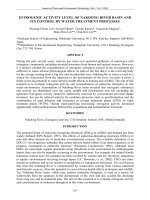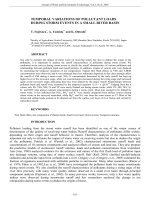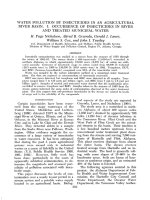Brackish water treatment reasearch in pilot scale using dual stage nanofiltration for domestic - drinking water supply in Thu Bon river basin
Bạn đang xem bản rút gọn của tài liệu. Xem và tải ngay bản đầy đủ của tài liệu tại đây (945.41 KB, 7 trang )
RESEARCH RESULTS AND APPLICATIONS
BRACKISH WATER TREATMENT REASEARCH IN PILOT
SCALE USING DUAL-STAGE NANOFILTRATION FOR DOMESTIC/
DRINKING WATER SUPPLY IN THU BON RIVER BASIN
Tran Duc Ha1*, Dang Thi Thanh Huyen2, Nguyen Quoc Hoa3, Nguyen Thi Hong Tinh4
Abstract: Due to the impact of climate change, the process of salinity intrusion occurs frequently in coastal
areas of Vietnam. Therefore, the main objective of this study is to evaluate the brackish water treatment
capacity of different nanofiltration (NF) processes for domestic and drinking water supply for residential
areas in Thu Bon river basin, where the salinity varies significantly within seasons. Results have shown
that during season change when the river’s salinity increases up to 17.5‰, application of dual-stage NF is
most appropriate. The energy costs were 8.28 and 33.4 $/m3 with salt concentrations of 1-6‰ and 6-12.5‰,
respectively. This dual-stage NF process not only guarantees the effluent quality to meet National Technical
Regulation on potable water (QCVN 01:2009/BYT), but also offers reasonable energy cost and finally can
heip to prolong the membrane lifespan.
Keywords: Drinking water treatment, dual-stage nanofiltration, Brackish water, variation of salinity with seasons.
Received: July 13th, 2017; revised: August 10th, 2017; accepted: November 2nd, 2017
1. Introduction
Desalination is a process of removing dissolved ions in the seawater, brackish water or underground
water. According to the International Desalination Association, there were 18,426 desalination plants operated worldwide as of June 2015, producing 86.8 million m3/d, providing water for 300 million people [1].
Desalination can be conducted via ion exchange, solar energy, distillation or membrane processes. The last
two methods, which are distillation and membrane processes, have been applied the most due to the high
efficiency and more reliability [2,3]. Distillation often requires large spaces for equipment and mostly relies
on the weather. Membrane technologies such as Reverse Osmosis-RO, Nanofiltration-NF, UltrafiltrationUF, Microfiltration-MF, etc., therefore, have been used tremendously in the past two decades because of
many advantages. Among the above membrane processes, RO and NF are considered most favorable for
desalination. RO can remove up to 99% dissolved ions, however, the capital cost and operation cost are
substantial due to material, pump energy, electricity and fouling [4]. With those constraints, the application of
RO in desalination for drinking water purpose seems to be a big challenge [4,5].
NF membrane has been proved to be quite effectiveness in controlling divalent ions, turbidity, residual bacteria, hardness ions, and seawater TDS (Fig. 1). The main advantage of NF membranes is lower
energy consumption and low capital cost compared to RO membrane [6-8].
The application of NF for desalination worldwide was in the early years of 2000 [9,10]. A single stage
NF was proved not so high removal efficiency. To maximize this outcome, using integrated membrane pro-
Figure 1. Rejection mechanism of Nanofiltration [5-14].
Assoc. Prof. Dr, Faculty of Environmental Engineering, National University of Civil Engineering.
Dr, Faculty of Environmental Engineering, National University of Civil Engineering.
3
MSc, Faculty of Environmental Engineering, National University of Civil Engineering.
4
MSc, Duy Tan University.
* Corresponding author. E-mail:
1
2
JOURNAL OF SCIENCE AND TECHNOLOGY IN CIVIL ENGINEERING
Vol. 11 No. 6
11 - 2017
149
RESEARCH RESULTS AND APPLICATIONS
cess (NF-NF or NF-RO) has been getting more of interest [11].. Al Taee and Sharif [7] concluded that the
energy consumption of NF-NF was 0.38 kWh/m3 lower than that of NF-RO, however TDS in the permeate
of NF-NF was 1030 mg/l while TDS in the permeate of NF-RO was only 125 mg/L. Nevertheless, NF has
high potential for application in desalination in some circumstances. According to [2], NF is comparable with
RO in treatment of low salt concentration seawater. At high salt concentration or wide concentration variable
water, NF can not meet the requirement.
In Vietnam, there have been some studies on desalination but mostly on low and stable salinity and
small-scale system [12]. In fact, the salinity varies quite substantialy within seasons. Thus, the main objective of this study is therefore to evaluate the brackish water treatment capacity of different nanofiltration (NF)
processes for domestic and drinking water supply for residential areas in Thu Bon river basin. The results of
this research would probably apply for other areas with similar conditions.
2. Materials and Methods
2.1 Feed water
Brackish water from Thu Bon River estuary has been used as feed water. This water is strongly
influenced by natural conditions and human life activities, so the tidal regime and water quality changes seasonally. The water transportation and fishing activities occur frequently in the region, which generate huge
amount of organic matter content, suspended solids, solids, trash, etc., in the water. In particular, the salinity
of this river varies considerably within seasons. The range of salinity at Cua Dai ward (Hoi An city, Quang
Nam province) where the pilot was installed (from August 1, 2012 - October 30, 2013) was 2.3-27.5‰, while
it was always mainly 20‰ higher than from June to August. With this condition, it is believed that it would be
impossible to apply a single process (whether it is conventional or advanced one) for treating this river for
drinking water purpose.
2.2 Experimental procedure
In this study, we treated the brackish water
using dual-stage NF filtration in two phases. Phase 1
involved testing with single-stage NF from 1/8/2012
to 13/11/2012. The feed water had a wide range of
salinity, ranging from 2.3‰ to 27.5‰. The purpose of
this step was to find the favorable salinity level that a
single-stage NF could handle, as well as find the appropriate salinity range for the next step. Sand filters
followed by UF pre-treatment units were employed in
order to remove residuals, viruses and bacteria. This
pretreatment step also helped to reduce membrane
fouling during the subsequent desalination stage.
After that, the water would undergo NF1. The implementation and equipment installed for this step are
shown in Fig. 2.
Figure 2. Diagram of a single NF process
Figure 3. Diagram of dual-stage NF process
In Phase 2, the dual - stage NF was tried
from 4/2/2013 to 12/6/2013. Based on the results of
Phase 1, the appropriate input salinity concentration
was found to proceed to Phase 2, where the minimum salinity of the input water NF2 feed would be
equal to the maximum salinity of the permeate (NF1permeate) at which it still obtains the NF2 permeate
< 0.495‰ [13]. The implementation plan and equipment installed for this step are shown in Fig. 3.
Both phase 1 and phase 2 experiments were
set up at site (see Fig. 4 for details).
The pilot was designed with capacity of 5 Figure 4. Process flow chart of the pilot unit at site
m3/d, operating 16h/d, including a composite filter
(Q=5 m3/d)
150
Vol. 11 No. 6
11 - 2017
JOURNAL OF SCIENCE AND TECHNOLOGY IN CIVIL ENGINEERING
RESEARCH RESULTS AND APPLICATIONS
with sand (D 600mm, 2000mm height); UF membranes NTU3360-K4R provided by Nitto Denko company,
Q = 7m3/h, N= 2 modules and Polyvinylidene Fluoride (PVDF) NF membranes (ESPA1- LF- 4040) were
provided by Nitto Denko company. This kind of membrane was reported to have high corrosion resistance.
The ceramic housing was stable and durable.
The operating pressure of NF system was set at 11±0.2 bar for both phases. The pressure and flowrate
were recorded everyday so as to be able to determine the recovery rate and salt rejection at different cases.
Recovery rate was estimated based on the following formula:
% Recovery rate = (QP/Qf)*100
(1)
Qf = QP + QC
(2)
where: Qf, QP, QC are the flowrates of the feed, permeate and concentrate.
Salt rejection was determined by:
% Salt Rejection = (TDSf ‒ TDSP)/(TDSf) × 100
(3)
In addition, the energy cost was also determined for treatmen����������������������������������������������������������������������������������������������������������������������������������������������������������������������������������������������������������������������������������������������������������������������������������������������������������������������������������������������������������������������������������������������������������������������������������������������������������������������������������������������������������������������������������������������������������������������������������������������������������������������������������������������������������������������������������������������������������������������������������������������������������������������������������������������������������������������������������������������������������������������������������������������������������������������������������������������������������������������������������������������������������������������������������������������������������������������������������������������������������������������������������������������������������������������������������������������������������������������������������������������������������������������������������������������������������������������������������������������������������������������������������������������������������������������������������������������������������������������������������������������������������������������������������������������������������������������������������������������������������������������������������������������������������������������������������������������������������������������������������������������������������������������������������������������������������������������������������������������������������������������������������������������������������������������������������������������������������������������������������������������������������������������������������������������������������������������������������������������������������������������������������������������������������������������������������������������������������������������������������������������������������������������������������������������������������������������������������������������������������������������������������������������������������������������������������������������������������������������������������������������������������������������������������������������������������������������������������������������������������������������������������������������������������������������������������������������������������������������������������������������������������������������������������������������������������������������������������������������������������������������������������������������������������������������������������������������������������������������������������������������������������������������������������������������������������������������������������������������������������������������������������������������������������������������������������������������������������������������������������������������������������������������������������������������������������������������������������������������������������������������������������������������������������������������������������������������������������������������������������������������������������������������������������������������������������������������������������������������������������������������������������������������������������������������������������������������������������������������������������������������������������������������������������������������������������������������������������������������������������������������������������������������������������������������������������������������������������������������������������������������������������������������������������������������������������������������������������������������������������������������������������������������������������������������������������������������������������������������������������������������������������������2 to 14.3‰ (Fig. 5), which
did not meet drinking water quality standards under QCVN 01: 2009/BYT (<0.5‰). The salt rejection
reached 47.4-91.5% and the recovery rate was low, ranging from 4-35%, depending on the salinity of
the input.
From Phase 1’s results, it was found that when the input water had a maximum salinity of 17.5‰,
the output was approximately 6 ‰ - equals the highest possible input salinity value to obtain accepted water
(meeting QCVN 01:2009/BYT). This means that for a two-stage NF process, the input salt concentration
could not exceed 17.5 ‰. Besides, the minimum limit would be 6‰ because if salt concentration is lower
than 6‰, one-stage NF is recommended to apply.
3.3 Recovery rate and
salt rejection of two-stage NF
(Phase 2)
Table 2. Effluent quality
No
Parameters
Average Value QCVN 01:2009/BYT*
1
pH
6.5-7.5
6.5-8.5
Fig. 7 shows clearly the recovery rate of 1st-stage NF process
2
Turbidity, NTU
<1
2
was from 10-35% for a range of sa3
Salinity, %o
<0.2
< 0.5
linity of 6-17.5‰. The permeate con4
CODKMnO4, mg/L
1,3
centration of NF1 was 0.5-5.5‰. The
5
SO42‒, mg/L
≤20
250
trans-membrane pressure was kept
constant at 10.5±0.5 bar. Membrane
6
Cl‒, mg/L
≤150
250 - 300
flowrate was from 13.2-20.6 L/min.
7
Coliform, MPN/100mL
0
0
After 2nd-stage NF, the permeate
salt concentration was 0.1-0.3‰. The * National Technical Regulations for drinking water purposes.
152
Vol. 11 No. 6
11 - 2017
JOURNAL OF SCIENCE AND TECHNOLOGY IN CIVIL ENGINEERING
RESEARCH RESULTS AND APPLICATIONS
overall salt rejection of the dual stage NF system was from 66.5 to 89.7% and the recovery rate was 32-47%
(Fig. 8). It is obvious that with additional NF stage, the salt removal increases to some extent and so does
the recovery rate. The permeate after dual-stage NF process all met the requirement of Vietnam standard
for drinking water purpose (Table 2). Azhar et al. [16] observed the recovery rate of their dual-stage NF was
18.9% at input salt concentration of 35‰ and decreased with the increasing salinity. As in this study, the input salinity was max 17.5‰ for dual-stage NF testing, the recovery rate was more than 30% which was quite
reasonable. AlTaee and Sharif [7] also observed high permeate TDS of 1.3‰ after dual-stage NF process at
the feed salinity of 43‰. Normally, the diffusion mechanism is limited at high concentration, leading to lower
recovery rate. In other speaking, at high salinity (i.e. > 20‰), dual-stage NF system will not be suitable for
desalination to meet drinking water quality.
Figure 7. Recovery rate of NF1 with input salt concentration of 6-17.5‰
Figure 8. Overall recovery rate of two-stage NF with input salt concentration of 6-17.5‰
Through the test, the trans-membrane pressure was relatively stable, the desiccation efficiency
(salt rejection) of dual-stage NF process was inversely proportional to input salt concentration. Increasing
salt concentration would decrease the salt rejection efficiency (Fig. 7). Similarly, the water recovery rates
after dual-stage NF process were also inversely proportional to the input salt concentrations (Fig. 8). At
maximum salt concentration (27.5‰), the desalination efficiency was only 47.5% and the recovery rate
was very low, only 4% (Fig. 6). The possible explanation may lie in that when a large number of salt ions
exists in feed water, and then in membrane pores, the layer of adsorbed water on pore walls will be thinner
due to “salting-out” effect, thus, the salt concentration in the permeate as well as permeate water will be
limited [17].
Compared to the artificial seawater desalination test conducted at lab-scale in our previous research
[12], the desalination efficiency at pilot scale was higher, and so was the recovery rate. The main reason for
this difference was that these experiments performed at 10.5±0.5 bar trans-membrane pressure, which was
8-10 bar higher than those in the previous experiment [12]. Basically, if the difference in membrane pressure
was eliminated, the results of this experiment would probably be similar to those of previous tests. This confirms the consistency of the results at both lab scale and pilot scale.
JOURNAL OF SCIENCE AND TECHNOLOGY IN CIVIL ENGINEERING
Vol. 11 No. 6
11 - 2017
153
RESEARCH RESULTS AND APPLICATIONS
Table 3. Energy cost for treatment of brackish water with salinity of 12.5 - 17.5‰
Pump
head
H (m)
Power
reserve
coef.
Density of
fluid
(T/m3)
0.87
110
1.5
1
0.85
1
0.460
7.50
7.50
110
1.25
1
0.85
1
3.304
7.50
7.50
33
1.25
1
0.85
1
0.991
7.50
7.50
15
1.25
1
0.85
1
0.451
Treatment
unit
QP
(m3/h)
P
(bar)
Rec.
rate
(%)
NF2
0.45
11
35.78
0.87
NF1
0.11
11
11.65
Sand filter
+ UF
7.50
3.3
100
Feed
7.50
1.5
Qf
Qpump
(m3/h) (m3/h)
Energy use per day (16 hrs), kW/day
Total
Engine
Pump
effiefficien- ciency
cy ηb
ηđc
Pump
power
(kWh)
83.291
Unit price of electricity, $/kW
0.91
Energy cost for 1m3 treated water, $
75.70
3.4 Energy consumption
In addition to membrane performance, energy consumption and cost is also discussed in this
section. The estimated energy cost for treatment
of 1 m3 brackish water treated using dual-stage NF
process was present in Table 3, when influent salinity was from 12.5-17.5‰.
Similar estimation for energy consumption
and cost was implemented at lower salt concentration. It was found that energy costs were 8.28 and
33.4 $/m3 at (1-6‰) and (6-12.5‰) salt concentraFigure 9. Comparison of energy cost for different
tions, respectively. When replacing two-stage NF
processes (dual-stage NF and with NF-RO)
process by NF-RO process, which had been described in details about the experimental system and testing procedure in previous study [14], the energy
cost of NF-RO was a bit lower at salt concentration of about 22.5‰, however, it was much higher (about
110 $/m3) when the salinity was higher than 22.5‰ (Fig. 9).
4. Conclusions
Thus, the main objective of this study is to seek for a proper solution for a wide range of salinity water via piloting at Thu Bon river site. The fluctuation range of salinity at Cua Dai ward (Hoi An city, Quang
Nam province) where the pilot was installed (from August 1, 2012 - October 30, 2013) was 2.3-27.5‰,
while it was always higher than 20‰ from June to August. With this condition, it is believed that it would
be impossible to apply a single process (whether it is conventional or advanced one) for treating water for
drinking purpose. A seven-month test with NF processes for brackish water treatment has revealed that
the nanofiltration process is a promising solution, providing drinking water for the lower Thu Bon River,
where salinity fluctuates significantly within seasons. In rainy season, when the input salinity is less than
6‰, one-stage NF can completely meet the water quality’s standard. When the input water has a salinity
in the range of 6‰ - 17.5‰, two-stage NF filtration is the appropriate choice. However, during the dry
season peaks, when the salinity was greater than 17.5 ‰, the two-stage NF filtration method was not
effective.
The experiment showed that the desalination efficiency (salt rejection) and recovery rate of the NF
filter were inversely proportional to the salt concentration of feed water. At the same time, the operation cost
of two-stage NF process is more reasonable at lower concentrations. In order to be able to treat water during
high salt concentration period, further research will be required.
154
Vol. 11 No. 6
11 - 2017
JOURNAL OF SCIENCE AND TECHNOLOGY IN CIVIL ENGINEERING
RESEARCH RESULTS AND APPLICATIONS
Acknowledgement
The authors express great acknowledgement to Ministry of Science and Technology, Vietnam, for National
Research Project Grant (Project #: DTDL.2010T/31).
Reference
1. Henthorne L. (2016), ”The Current State of Desalination. International Desalination Association”, Retrieved from />2. Wilf M. (2010), The guide book to Membrane Desalination Technology, Balaban Desalination Publications.
3. Al-Karaghouli A., Renne D., Kazmerski L.L. (2009), ”Solar and wind opportunities for water desalination in
the Arab regions”, Renewable and Sustainable Energy Reviews, 13(9):2397-2407.
4. Noble R.D., Stern S.A. (1995), Membrane Separations Technology: Principles and Applications-Volume 2,
Elsevier Publisher.
5. Van Rijn C.J.M. (2004), Nano and Micro Engineered membrane technology, Elsevier Publisher.
6. Hassan A.M., Al-Sofi M.AK., Al-Amoudi A.S., Jamaluddin A.T.M., Farooque M., Rowaili A., Dalvi A.G.I.,
Kither N.M., Mustafa G.M., Al-Tisan I.A.R. (1998), “A new approach to membrane and thermal seawater
desalination processes using NF membranes (Part 1)”, International Desalination & Water Reuse Quarterly,
8(1):53-59.
7. AlTaee A., Sharif A.O. (2011), “Alternative design to dual stage NF seawater desalination using high rejection brackish water membranes”, Desalination, 273(2-3): 391-397.
8. Le Gouellec Y.A., Cheng R.C., Tseng T.J. (2007), A Novel Approach to Seawater Desalination Using Dual-Staged Nanofiltration, IWA Publishing.
9. Tortajada C. (2006), “Water management in Singapore”, Inter.J.of Water Res.Dev., 22(2):227-240.
10. Diawara C.K. (2008), “Nanofiltration Process Efficiency in Water Desalination”, Sep.&Pur.Reviews,
(37):302-324.
11. Misra B.M., Tewari P.K., Bhattacharjee B. (1999), “Futuristic Trends in Hybrid System for Desalination”,
IDA Conference, San Diego, 311-320.
12. Hoa T.D., N.Q. Dong. P.D. (2012), “Research on seawater and brackish water treatment for domestic use
using NF at lab-scale”, Journal of science and technology in Civil Engineering, (13):27-34.
13. QCVN 01:2009/BYT, Vietnam National Technical Regulation for drinking water purpose.
14. Ha T.D. (2012), Application of low-pressure membrane in desalination of seawater in coastal areas and
islands of Vietnam, Report of National research project # DTDL.2010T/31, Ministry of Science and Technology.
15. Ahmed A.L., Ooi B.S, Mohammad A.W., Choudhury J.P. (2004), “Development of highly hydrophilic
nanofiltration membrane for desalination of water treatment”, Desalination, (168):215-221.
16. El Azhar F., El Harrak N., El Azhar M., Hafsi M., Elmidaoui A. (2013), “Feasibility of Nanofiltration process in dual stage in desalination of the seawater”, Journal of Applied Chemical, 5(1):35-42.
17. Luo J., Wan Y. (2011), ”Effect of highly concentrated salt on retention of organic solutes by nanofiltration
polymeric membranes”, Journal of Membrane Science, 372(2-2):145-153.
JOURNAL OF SCIENCE AND TECHNOLOGY IN CIVIL ENGINEERING
Vol. 11 No. 6
11 - 2017
155









